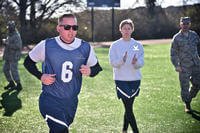If you do not get your blood drawn during an annual physical, you should -- especially if you are aging into your 40s. This way, you can monitor the five critical biomarkers in the metabolic blood test and other measurements that can accurately determine your future.
The beauty of these markers is that you can fix these scores with a better diet, sleep and daily exercise. Medicine may sometimes be needed, but you need to know your scores in the following areas: blood sugar, triglycerides, high-density lipoprotein (HDL) cholesterol ("good cholesterol"), blood pressure and waist size.
A 2018 study found that only one in eight Americans are considered metabolically healthy, with more recent studies showing that number had improved to one in five. Here are the numbers that should alarm you:
- Blood pressure of (systolic/diastolic) 130/85 mm/Hg or higher.
- Triglyceride level of 150 mg/Dl or higher.
- Low HDL cholesterol less than 40 md/dL in men or less than 50 mg/dL in women.
- Elevated fasting blood sugar readings of 100 mg/dL or greater.
- Waist circumference greater than 40 inches in men and 35 in women.
The Mayo Clinic defines metabolic syndrome, or MetS, as a cluster of conditions that occur together, increasing your risk of heart disease, stroke and Type 2 diabetes. These conditions include the ones listed above and are caused by being overweight and inactive physically. A person is diagnosed with MetS if they have three of those five markers, and there seems to be a parallel rise in MetS with obesity and diabetes.
Insulin Resistance Ratio and Metabolic Health
Another combination of the above readings is dividing the triglycerides by the HDLs (TG/HDL) to get the TG/HDL ratio. This combination is often referred to as the "insulin resistance ratio" and is associated with higher risks of major health issues such as diabetes, stroke and heart disease in the future. Dr. James Greenwald of Specialty Health concurs but also recommends keeping this ratio score below 3.5 to be healthy.
Insulin resistance (IR) is a relationship between insulin, blood cells and blood sugar. When you eat sugar, you will get an increase in blood-sugar readings. This is natural. We use it for energy, or insulin helps us lower that number. Insulin allows glucose (sugar) to enter the blood cells, where it's used for energy. When the blood cells don't respond well to insulin, the blood sugar gets elevated and the pancreas produces more insulin to help glucose enter cells. Over time, the pancreas can't keep up, and blood-sugar levels remain elevated. Type 2 diabetes soon follows, as well as other MetS symptoms.
Preventing MetS
Many of the MetS symptoms are the same as the onset of Type 2 diabetes. These include a large waist size, high blood-sugar readings, increased thirst, frequent urination and blurred vision. Preventing or reversing these symptoms will require a healthy lifestyle change, not just a diet or a workout program. The shortlist includes getting 30 minutes of physical activity daily; eating natural foods (mostly unprocessed), such as fruits, vegetables, lean protein and whole grain sources; losing weight; and avoiding smoking and alcohol consumption.
Our age and body weight are the most significant risk factors for diabetes and MetS. As age and weight increase, so do our risks. If you want a good goal this year, get a blood test and focus on making activity and dietary changes to see whether you can beat those scores in 6-12 months.
If you are not assessing yourself, you are only guessing. Don't guess at your future health. Go to the doctor and ask for a metabolic blood panel, a routine blood screening done by every doctor or medical professional. Do this annually. These essential and inexpensive readings can help you realize you need to change and focus more on your internal numbers.
You Can Change Your Future in Less Than a Year
Make it part of your daily challenge to improve these scores and then on "game day" -- your annual physical appointment -- see whether you can set a personal record and improve across the board.
See a sample story of a police officer who turned his life around in less than a year in the related articles below:
• Blood Screening Part 1
• Blood Screening Part 2
• Blood Screening Part 3
Hundreds of articles in the Military.com Fitness Section further help you learn more about nutrition, exercise, sleep and stress. Understanding how to optimize nutrition, exercise and sleep and mitigate stress will help you change your life and avoid the above scores that place you in danger of chronic illnesses.
Want to Learn More About Military Life?
Whether you're thinking of joining the military, looking for fitness and basic training tips, or keeping up with military life and benefits, Military.com has you covered. Subscribe to Military.com to have military news, updates and resources delivered directly to your inbox.


















